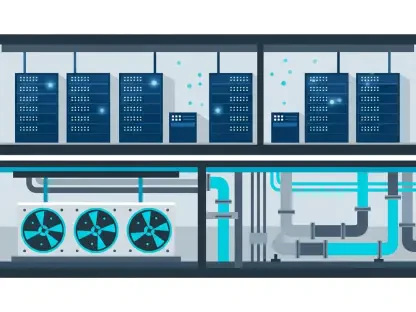Imagine a world where high-speed internet is no longer a luxury confined to urban centers, but a fundamental resource accessible even in the most remote corners of the planet, bringing connectivity to millions in rural areas, on open seas, and in disaster-stricken regions through revolutionary technology. Starlink, an ambitious initiative by SpaceX, is at the forefront of this transformation, leveraging a vast network of low-earth orbit (LEO) satellites to redefine internet access. This review dives deep into the capabilities of this cutting-edge service, exploring how it outperforms traditional providers and shapes the future of global communication.
Understanding the Starlink Revolution
Starlink aims to bridge the digital divide by delivering high-speed internet through a megaconstellation of satellites positioned just 340 miles above Earth. Unlike conventional geostationary orbit (GEO) systems, which operate at a distant 22,000 miles, Starlink’s closer proximity slashes signal travel time, promising unprecedented performance. This innovative approach targets underserved regions, offering a lifeline to communities long neglected by terrestrial infrastructure.
The mission extends beyond mere connectivity; it challenges the status quo of internet service providers. By focusing on areas where traditional broadband fails, Starlink addresses a critical global issue—access inequality. Its relevance lies in empowering individuals, businesses, and emergency services with reliable communication tools, setting a new benchmark for what internet service can achieve.
Key Features and Performance Breakdown
Vast LEO Network and Rapid Expansion
At the heart of Starlink’s success is its sprawling constellation of nearly 8,000 satellites, a number that continues to grow with over 2,300 launched in the past year alone. This rapid deployment ensures extensive coverage and capacity, distinguishing it from GEO competitors who rely on just a handful of distant satellites. The scale of this network translates into a robust system capable of serving millions worldwide.
The proximity of LEO satellites to Earth is a critical advantage, enabling faster data transmission compared to GEO setups. This structural edge allows Starlink to cater to high-demand scenarios, from rural households to maritime vessels, with a level of consistency that older systems struggle to match. The ongoing expansion signals a commitment to enhancing global reach even further.
Unmatched Speed and Latency Metrics
Performance data paints a clear picture of Starlink’s dominance, with median download speeds reaching 104.71 Mbit/s and latency clocking in at 45 milliseconds as of the latest reports. These figures starkly contrast with GEO providers like HughesNet, which offers 47.79 Mbit/s download speeds and a latency of 683 milliseconds, and Viasat, at 49.12 Mbit/s download and 684 milliseconds latency. The difference is transformative for users reliant on real-time applications.
This performance gap underscores why Starlink is preferred for activities like video conferencing and online gaming, where delays can disrupt functionality. While GEO operators have made strides in improving their networks, their inherent orbital limitations prevent them from closing the divide. Starlink’s metrics highlight a shift toward a more responsive internet experience, redefining user expectations.
Market Innovations and Strategic Moves
Starlink’s approach to market penetration is as bold as its technology, with pricing strategies like free equipment offers and reduced subscription fees in certain regions. These initiatives lower the entry barrier for new users, particularly in areas with limited connectivity options. Such tactics have fueled rapid adoption across diverse demographics.
A notable trend is the integration of satellite services with terrestrial networks through direct-to-device (D2D) connectivity, enhancing coverage in remote zones. Partnerships with mobile carriers like T-Mobile and Rogers Communications exemplify this hybrid model, enabling services such as SMS texting in areas beyond traditional wireless reach. This adaptability positions Starlink as a versatile player in the connectivity landscape.
Subscriber growth further illustrates its market impact, with over 6 million users globally compared to significant declines for GEO operators—HughesNet down 29% over the past three years and Viasat down 68% over a similar period. This shift reflects consumer preference for superior service and innovative pricing, cementing Starlink’s role as an industry disruptor.
Real-World Impact Across Sectors
Starlink’s applications span a wide range of sectors, bringing internet to rural communities previously cut off from digital resources. Farmers, students, and small businesses in isolated areas now access tools and markets that were once out of reach, fostering economic and educational growth. This deployment addresses long-standing inequities in access.
Beyond land, Starlink serves maritime and aviation industries, ensuring connectivity for ships and aircraft navigating vast, unconnected expanses. Unique collaborations, such as those with mobile carriers for D2D services, extend its utility to emergency communications in remote locales. These use cases highlight the technology’s flexibility in meeting diverse needs.
Humanitarian efforts add another dimension to its impact, with free services and equipment provided during crises like floods in central Texas. By enabling communication in disaster zones, Starlink supports relief operations and community recovery, demonstrating a commitment to societal good alongside commercial goals.
Challenges on the Horizon
Despite its achievements, Starlink faces hurdles that could temper its growth. Regulatory challenges around spectrum allocation and satellite deployment require navigation through complex international frameworks. Compliance with varying global policies remains a persistent obstacle to seamless expansion.
Capacity constraints in high-demand areas have led to surcharges, potentially alienating some users. Environmental concerns also arise from the sheer scale of the satellite constellation, with debates over space debris and light pollution gaining traction. These issues demand innovative solutions to balance growth with sustainability.
Efforts to address these challenges are underway, including technological advancements to optimize network efficiency and active collaboration with regulators to mitigate environmental impacts. While not fully resolved, these steps indicate a proactive stance toward maintaining long-term viability in a competitive field.
Looking Ahead to Starlink’s Future
The trajectory for Starlink points to further innovation, with plans to expand D2D services and launch additional satellites to bolster global coverage. These developments aim to solidify its position as a leader in closing connectivity gaps, particularly in underserved regions. The focus on scalability remains a core strategy.
Competition looms from initiatives like Amazon’s Project Kuiper, which currently trails with only 78 satellites in orbit against a mid-2026 deadline for 1,600. This lag suggests Starlink’s lead is secure for now, though the landscape could shift as rivals accelerate efforts. Keeping pace with technological and market demands will be crucial.
The long-term implications of Starlink’s dominance could redefine industry standards, pushing toward universal internet access. Its influence may inspire broader adoption of LEO technology, ultimately transforming how connectivity is perceived and delivered across the globe.
Final Thoughts and Next Steps
Reflecting on Starlink’s journey, its technological edge in speed and latency over GEO competitors stands as a defining factor in reshaping the satellite internet market. The strides made in subscriber growth and real-world applications underscore a pivotal shift in how connectivity barriers are tackled. Its strategic innovations mark a turning point for an industry long constrained by outdated systems.
Moving forward, stakeholders should prioritize addressing regulatory and environmental challenges through collaborative frameworks, ensuring sustainable expansion. Users and policymakers alike can advocate for policies that support LEO technology while safeguarding orbital space. As Starlink continues to evolve, exploring partnerships and hybrid connectivity models offers a pathway to sustain its transformative impact on global access.









